#Hakone Ropeway
Explore tagged Tumblr posts
Text
Beyond Words 🗻

116 notes
·
View notes
Text
Hakone Ropeway
The gondola lift up the Schauinsland is very good, but my favourite so far is definitely the Hakone Ropeway. After the train into Hakone, another train to Gôra, and a funicular, the last leg up the mountain is covered by this funitel, on which cars are suspended by two cables rather than one.

The Ropeway carries passengers up to Ôwakudani through the forest... at least as far as that ridge.
Mount Hakone is an active volcano and "Ôwakudani", 大涌谷, literally means "great boiling valley", featuring bright yellow sulphur deposits and gas vents. Going from lush green slopes to the mineral hellscape of the crater in an instant is a breathtaking contrast, and one of my all-time favourite moments from my travels.

The Ropeway can obviously only run when the volcano isn't too active. When I first rode it in 2016, staff handed out damp tissues for passengers to cover their nose and mouth and protect themselves against the gases. After traversing the crater, the Ropeway continues down the other side of the mountain to the North end of Lake Ashi, where one would continue a tour by boarding one of the "pirate ships" that cruise on the lake.

#Japan#Kanagawa-ken#Hakone#Mount Hakone#Ôwakudani#volcano#sulphur#it can get smelly up there#I'll probably say more about that next time#Hakone Ropeway#train#kind of#I mean they run on two cables#kind of like rails#箱根#火山#大涌谷#ロープウェイ#2023-08
9 notes
·
View notes
Text
神奈川県
Japanese Prefectures: Kantō - Kanagawa
都道府県 (とどうふけん) - Prefectures of Japan
Learning the kanji and a little bit about each of Japan’s 47 prefectures!
Kanji・漢字
神 かみ、かん~、こう~、シン、ジン、かな gods, mind, soul
奈 いかん、からなし、ナ、ナイ、ダイ Nara
川 かわ、セン stream; river
県 ケン prefecture
関東 かんとう Kanto, region consisting of Tokyo and surrounding prefectures
Prefectural Capital (県庁所在地) : Yokohama (横浜市)

Kanagawa Prefecture is located just south of Tokyo. It is home to many day trip destinations from Tokyo, including the cities of Kamakura and Hakone. The prefectural capital of Yokohama on the Pacific coast is Japan's second largest city and its major port, including many multicultural influences such as a China Town and the Minato Mirai building. The port areas are also major centres of bonito and tuna fishing. Inland, Kanagawa has a flourishing agricultural area producing flowers and dairy products for the Tokyo market.
Recommended Tourist Spot・おすすめ観光スポット The Great Buddha of Kamakura - 鎌倉大仏

The Great Buddha of Kamakura (source)
At the Buddhist temple Kotoku-in (高徳院) in Kamakura stands the 11-metre tall 13th-century bronze statue of Amida Buddha. Initially housed in a wooden hall, it was restored in the Edo period (1603-1868) after being damaged over the years by typhoons and earthquakes and now towers over the grounds of the temple. The Great Buddha of Kamakura is the second largest seated Buddha in Japan.
After you visit the Great Buddha, you can also find other Zen Buddhist temples, which are among the oldest and most beautiful in the country, and most in walking distance from each other. Enoshima and the Kamakura beaches are also nearby.
Regional Cuisine - 郷土料理 Kuro-tamago (Black eggs) - 黒卵 (くろたまご)

Kuro-tamago or Black eggs (source)
It may seem strange, but this popular souvenir from the Owakudani (大涌谷 or Great Boiling Valley) in the resort town of Hakone in Kanagawa Prefecture gets its distinctive black color from being boiled in natural hot spring water for 60 minutes at a temperature of 80°C, then steamed at 100°C for 15 minutes in steel baskets over natural hot spring water. The natural hot spring water contains sulfur and iron, thus turning the egg shells black. The Kuro-tamago, or Black Eggs, have a slight sulfur smell (although the whole valley has this smell so you might not notice). They are safe to eat and are said to add 7 years to your lifespan! (You shouldn't eat more than two at one time though, as the lifespan elongating effects will then be nullified, or you might just feel slightly sick).
Owakudani is an active volcanic valley that is known to locals as Jigokudani (地獄谷 or Valley of Hell) due to the sulfurous volcanic gasses and steam from the natural hot spring waters. There are many resorts nearby in Hakone which tap into these natural hot springs. The valley was formed due to the last eruption of Mt Hakone about 3,000 years ago. On clear days, you have a great view of Mt Fuji. There is also a ropeway that will take you over the active volcanic area, but sometimes it can be closed when the volcanic activity picks up and the volcanic gasses increase, so check before you visit.
Kanagawa Dialect・Kanagawa-ben・神奈川弁
Kanagawa-ben is a basket term used to describe the dialects spoken in the prefecture, but there is no single unified dialect.
1. うんめろ unmero very, a lot
うんめろ美味しい (unmero oishii)
Standard Japanese: たくさん、とても (takusan, totemo)
とても美味しい (totemo oishii)
English: very, a lot
very delicious
2. あんきだ anki da I'm relieved, it's a relief
おめーらガ、みんなこどまーでけーからあんきだなー (omeera ga, minna kodomaa dekei kara anki da naa)
Standard Japanese: 安心だ (anshin da)
お前の家は、みんな子どもが成長しているから安心だな (omae no ie wa, minna kodomo ga seichou shite iru kara anshin da na)
English: I'm relieved
It's a relief because all the children in your home are growing up well
3. あっちかし・こっちかし (acchikashi, kocchikashi)
椅子を並べるのはこっちかし? あっちかし? (isu o naraberu no wa kocchikashi? acchikashi?)
Standard Japanese: あちら側・こちら側 (achiragawa, kochiragawa)
椅子を並べるのはこちら側? あちら側? (isu o naraberu no wa kochiragawa? achiragawa?)
English: that side, this side
Should I arrange the chairs this way? That way?
4. うっちゃる (uccharu)
ゴミをうっちゃる (gomi o uccharu)
Standard Japanese: 捨てる (suteru)
ゴミを捨てる (gomi o suteru)
English: to throw away
Throw away your trash
5. かったるい (kattarui)
遠くて歩くのかったるいな (tookute aruku no kattarui na)
Standard Japanese: 面倒くさい、だるい (mendoukusai, darui)
遠くて歩くのだるいな (tookute aruku no darui na)
English: bothersome, tiresome
It's so far that it would be a pain to walk there
More Kanagawa dialect here (Japanese site).
#japanese prefectures#日本語#japanese#japanese language#japanese langblr#langblr#studyblr#都道府県#神奈川県#kanagawa
33 notes
·
View notes
Text

箱根ニッキ:大好きなロープウェイとか船に乗った話
Hakone Nikki: A story about my favorite ropeway and boat ride.
2 notes
·
View notes
Text
Japan Day 6 Hakone!
Today we traveled to a mountain town called Hakone.
We got to see mt Fuji on the train and honestly the train ride of just having a full two hours to sit and not do anything was really nice

Then we saw an ad for the Hakone open air muesuem and it was really cool! Highlights including the foot bath, giant fried egg that you could stand on, a stained glass tower, a hilarious interactive display where they put your face on a digital artwork in the museum background and a Picasso room.
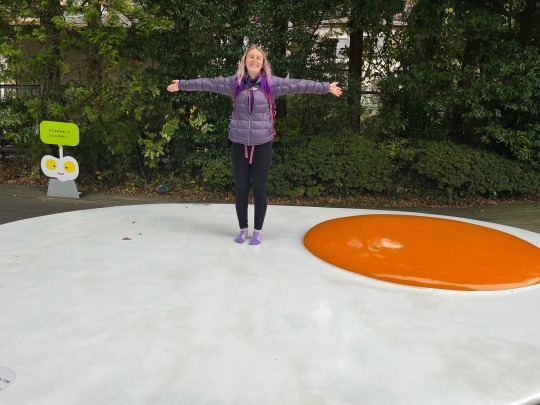
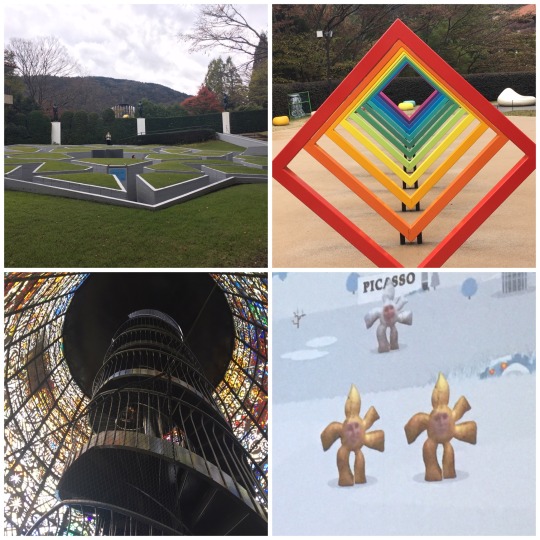
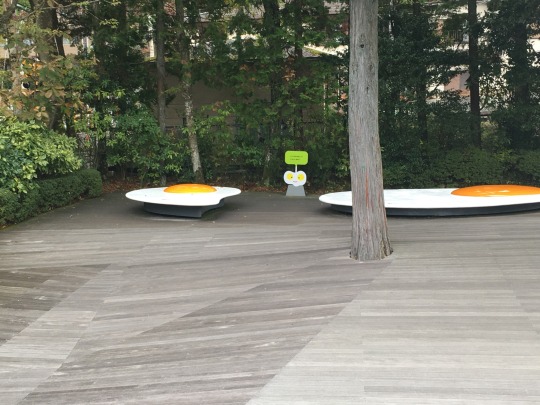


We then got to take a gondola up to the mountain top and down to the lake where we got to take a pirate ferry boat across!
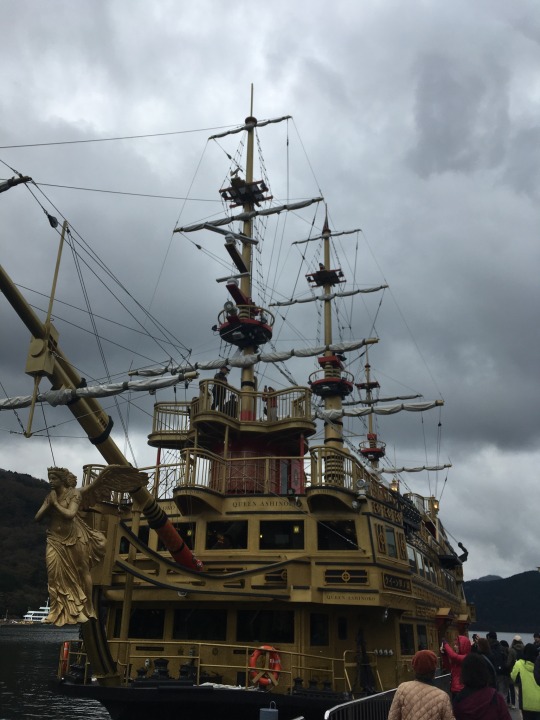
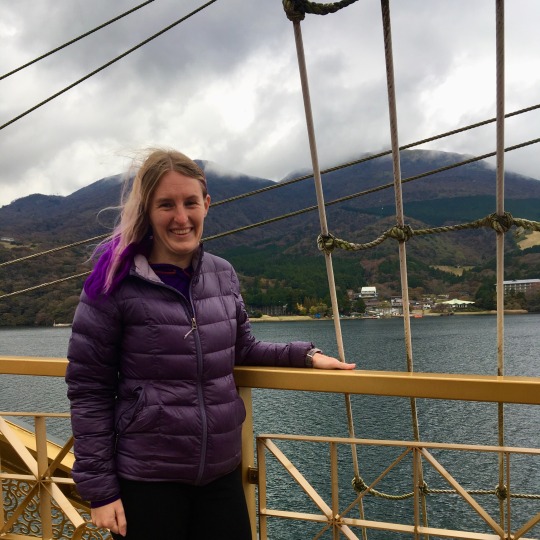
And then after some brief chaos with the bus system (it just never came) and taking a taxi (that also went to the wrong place at first) we finally got to check in at the Ryoken and enjoy our private onsen. We also got to enjoy this many courses traditional dinner. There was a lot of sea food and my boyfriend kept trying to get me to keep trying it so I didn’t have the best time. But the non sea food parts were very good and everything was super pretty.
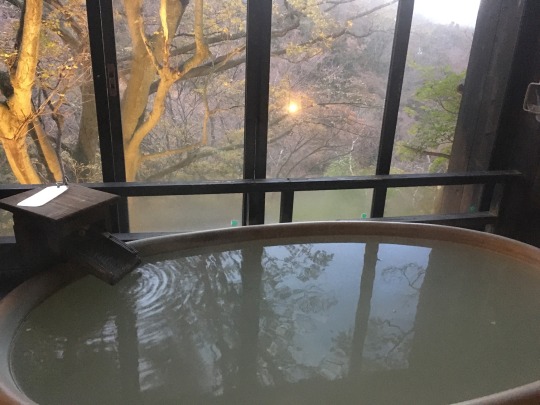

Overly long and tmi travel diary
We get up early to catch a two hour train to Hakone. My tummy is just a little a bit upset this morning. Between travel, stress, being on my period, and lots of new food it’s been through a lot. I also feel like I haven’t been pooping enough. But they could just be not eating enough for how much walking we’ve been doing.
The train is really nice and we get some lovely views of the sun rising over the mountains. I update my travel diary, take a nap and then we get to see a view mt Fuji through the window. It is impressively taller than everything else around it.
We transfer to a smaller train and then a another mountain train. And then it’s a cable car.
5000 yen for Hakone free pass for transit. I am down to 1000 yen in cash. (Really 3000 as I later find another 2000 yen note in my pocket that I didn’t see before)
5000 yen for Hakone free pass for transit. I am down to 1000 yen in cash. (Really 3000 as I later find another 2000 yen note in my pocket that I didn’t see before)
We see an ad for Hakone open air museum and decide to get off a stop early and go see it. (I think I paid by credit card, 1200 yen each including a 200 yen discount from our Hakone passes).
The museum has a couple galleries where you can’t take pictures (although my bf tried) but mostly it’s big outdoor sculptures. There’s a fun star maze and some garden areas, and the whole place is set up with a great view of the surrounding mountains. I love the Picasso room. I hadn’t realized he did so many ceramics. We stop at a foot bath where we get a towel out of a vending machine for 100 yen. It’s small but a surprisingly nice towel and is branded to make it a souvenir. There’s a big tower made of stained glass that’s really fun. And a fried egg sculpture that you can stand on! I deeply love getting to stand on or interact with art.
After the museum we go grab lunch at a little road side restaurant. Ignoring the delightful ninja cafe next door full of authentic delicacies such as spaghetti and ninja ice cream.
Foot bath and a vending machine towel for 100 yen from Anthony
I get pork ginger and rice for lunch in the card.
After lunch we take the ropeway (hanging cable car) to the top of the mountain. On the side of the mountain are a bunch of thermal vents venting steam. You can see the yellow sulfur deposits around it. Supposedly you can get a black egg cooked in the sulfur water that adds seven years to your life, but we don’t get it.
We spend a little time at the top looking at the mountain and then head down the other ropeway to the lake. And then we get to ride a pirate ship!
The pirate ship we get is called queen ashinoko and is gold and red. We take it across the lake. I love all the sights and being on a boat and my bf tolerates it and enjoys the view. It does get a little chilly but is otherwise a delight. I see a lady take a bunch of silly titantic esque photos on one of the interior balconies. Sometimes it’s such a delight to watch other people live their best lives.
After the ferry we try to get on a bus to go to our hotel but it’s super delayed and the lines are insane so we give up and hail a taxi. Anthony impresses the taxi drive with his handful of Japanese and good pronociation and they have a good chat. The taxi ride ends up being just shy of 5000 yen which is more than I thought it would be (and we get a little turned about by the directions. Anthony gave the hotel name but written in English and just said like Japanese so we go to a bit of the wrong place first and then have to give the actual address which gets us to the right place.
We head into the rykone and They take your shoes and give slippers. The ryokan has a very traditional feel. We are shown where our private onsen will be and then to our rooms. Our rooms have yakata (?)robes in them to wear around. Mine is pink and my bfs is blue. They both have blue overcoats. We head down to the onsen before dinner. The sun is starting to set and the view is really pretty. The leaves are mostly either green or fallen but it’s still so peaceful. We shower first in the attached shower and then step into the sulphuric mineral water. It’s so cloudy and so hot but also feels so good. It would be better if it were like five degrees cooler but it’s still lovely. We hang out for a bit stepping in and out to cool off as needed. They’ve also put a thermos jug of cold water which is perfect.
We rinse back off and head back to our room for dinner.
Dinner will be served in our room and is a traditional set meal.
It starts with appetizers and is mostly fish which makes me sad. I knew this was likely that I wouldn’t like a good portion of it but it still makes me sad. The plates and the way everything is presented is so lovely. I try to focus on how fun it is and not how gross all the fish is. I get talked into trying a piece of the raw tuna and it’s awful. I also try a piece of sushi, the first bite is okay but when I take the second bite I realize that the first bite had way less fish in it and I Gag a little and almost throw up. I also try one of the little fish eggs since my bf claims they are mostly salty and not fishy. False. Very false and very gross. Combined with new and questionable vegetables I’m way past my limit of new food. Luckily there are some things that I like too. There’s a beef dish that is so delicious and comes with the cutest little wedge of cheese.
There’s also a hot pot like thing with pork and milk that is so cool and delicious.
We get sweet pudding for dessert.
After dessert we go have more onsen time. It’s fun to be in it at night with it being all dark. Unfortunately it’s too hot to really cuddle in the onsen which bums we out.
We head back up to the room and watch Japanese tv before bed. We get to see some sumo wrestling, a cooking show and some weird childrens tv show. I get a little sad because I had such high expectations for this part of the trip and then I didn’t get to cuddle or do more than cuddle and didn’t like a lot of the food.
It’s a traditional style hotel room so it has two twin beds. We push them together(I push mine into his) but it’s not really what I wanted. I take a moment to cry a little in the bathroom and I feel a bit better. It’s hard when you feel disappointed in something you feel like you should really be enjoying.
#japan day 6#travel diary#overly long travel diary#japan#this was November#we are all just ignoring how slow I am at this#plus it’s fun to go back and relive
10 notes
·
View notes
Text
Chapter 7 Trivia
A-Hakone we will go, A-Hakone we will go, Heigh-ho, the volcan-o, A-Hakone we will go.

Senku seems determined to break all the pots even if, to me, it doesn't match up with what his goals are.
However I'm imagining whoever Tsukasa revived next was using pots crafted by Tsukasa's hand. (If they decided to remake any)

~80km, or about 17 hours of walking (at about 5km/hr), basically as the crow flies. Taiju could run it in 5 hours, going at 16 km/hr. They stop for one night and probably do the trip in two days.
The Tokyo <-> Hakone route becomes pretty important down the road.
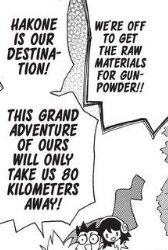
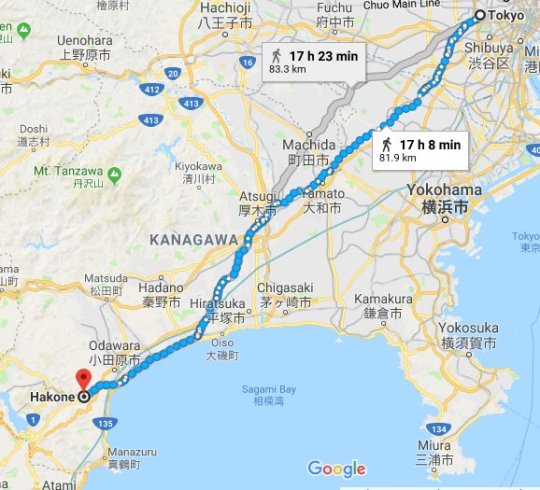
With Senku's crude sextant, he just lines the sights up with the sun and reads the angle that way. A proper sextant has mirrors, so you adjust the angle until the horizon and sun are aligned in the view piece.
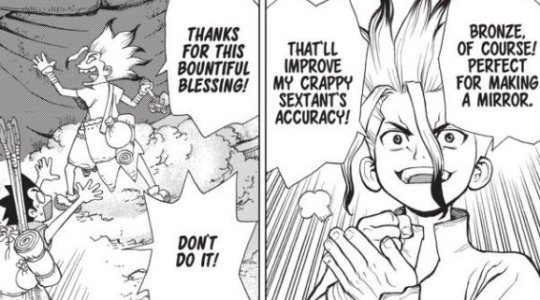


If we assume the sun rises at 5:30AM (it's currently around springtime), then 35,970 seconds later is 10 hours later, making it about 3:30PM.

Modern buildings simply aren't built to last thousands of years. Needs change, and thus things are only built to last ~100 years, so it makes sense that there's nothing left.
If you wanted to build something to last 3,700 years, check out the Great Pyramids for inspiration!
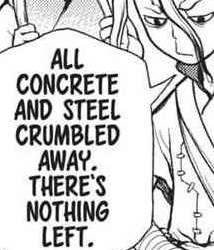
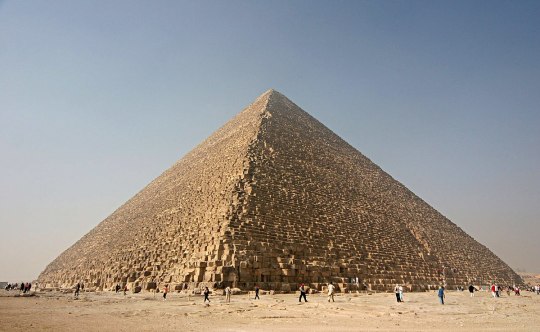
Interestingly, skyscrapers may last longer because of the amount of glass in them and the strength of the concrete. This is probably why Roppongi hills is still identifiable but people's houses aren't.
Obviously this doesn't account for severe natural disasters.
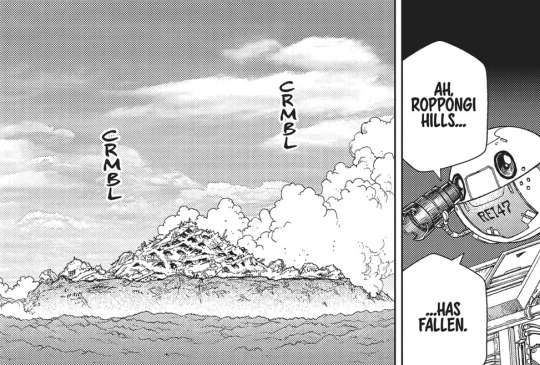
If they're in Kamakura, they did not go as the crow flies, and the whole trip becomes 94km (20 hours of walking).
Fun fact: if you visit the Great Buddha, you can peek inside the hollow structure from the back.
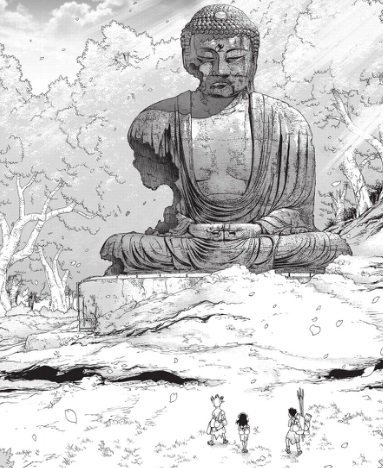

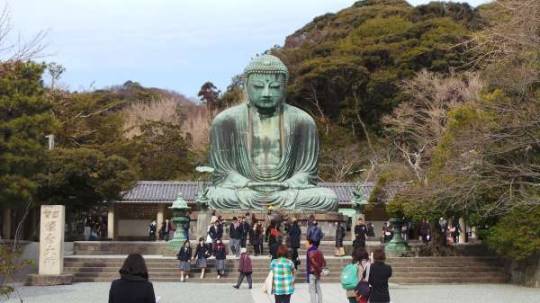
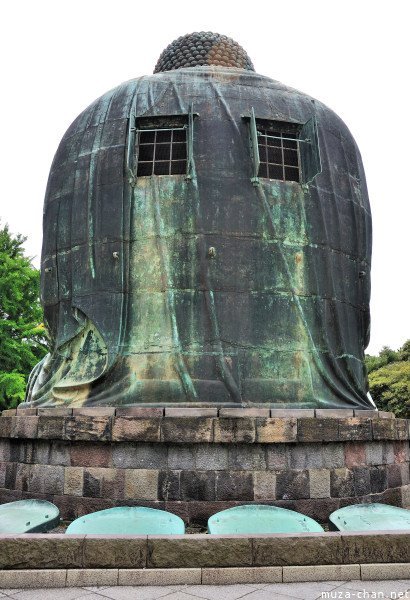
Bronze can last an incredibly long time. the Antikythera Mechanism survived for around 2000 years despite the seawater thanks to bronze's resistance to corrosion. Like Senku says, bronze will also leach copper into the soil, which can kill plants if there's a high amount present.
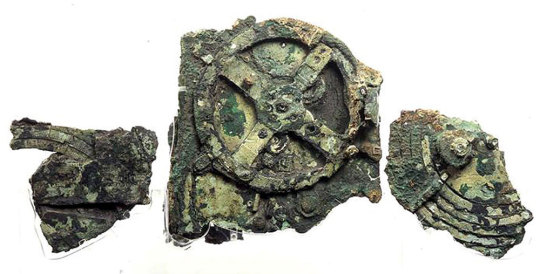
Prunus yedoensis is one of the most widely planted cherry cultivars, and they're all clones of the same plant. This works by grafting a branch onto another tree, making the "top half" a cherry tree, or alternatively just using cuttings.
The tree itself has a short lifespan.


These are Japanese Horsetail, better known as tsukushi. They're similar to asparagus in appearance and taste, but have hollow stems.
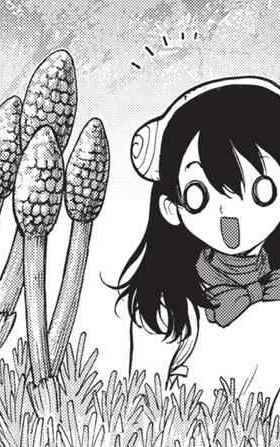

Senku needs one hand on his stick to check stability, so he holds his shoes in one hand. Yuzuriha can hold her shoes in both hands. Taiju needs both hands to hold all their stuff, so his are tucked into his belt.
I thought it was a nice detail :)

Nitric acid burns skin, so I assume RF would too, but Yuzuriha is saying it's cold? Is she talking about the stone feeling cold? If that part of her foot is fully stone, how is she walking if she can't bend her toes? Is it just a stone layer on top of skin?
I've got questions.

Detective Tsukasa is on the case! He seems to have some basic tracking knowledge, but more impressively he can predict Senku's moves very accurately using both his knowledge of science and possibly fighter's instincts. Senku doesn't stand a chance…
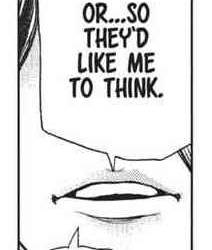
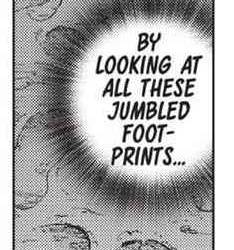
Hakone is in a volcanic region with lots of natural onsen and a view of Mt. Fuji to the northwest. This scene resembles Owakudani - a geothermic area north of Mt. Hakone, along the Hakone ropeway route.
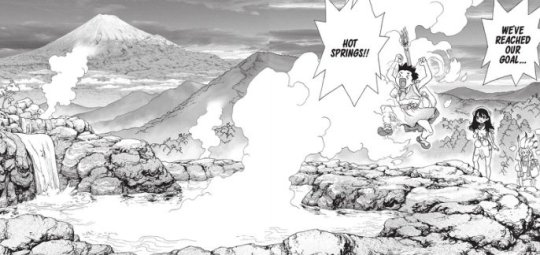
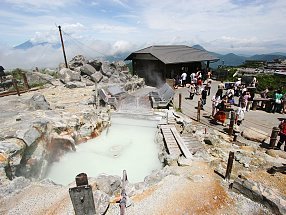

Owakudani natural hot springs seem to range in temperature between 36.3 and 96.0°C. There's no telling what the exact temperature of the pool they chose is, but Senku obviously can't take the heat.

Senku uses the terms "gunpowder" and "black powder" interchangably. This isn't technically incorrect, as up until recently they were the same thing. Nowadays, we also have smokeless powder that can be used for the same purpose.


(Also, if you don't recognise the tune at the beginning of the thread it's "A-Hunting We Will Go", a folk song/nursery rhyme.)
Finally, several of these were taken directly from Caleb Cook's trivia, so credit where it's due.
14 notes
·
View notes
Text










Day four, Hakone-Yumoto
Out of the hotel and on the train to Hakone-Yumoto from Shinjuku by 10am.
Dropped our bags at the hotel then hopped on a bus to the Hakone checkpoint, from here we walked lakeside through the forest to two viewpoints, the second was wonderfully private with an amazing view. An even better view was when I turned around to see that Michael was down on one knee and was asking me to marry him, I guess I had to say yes 😉
We continued walking through the forest and then along to Motohakone-Ko and got on a ferry boat to Togendai to get the Hakone Ropeway towards Sounzan.
Once there we had to get off to change lines but there was a viewpoint that had an onsen footbath which was lovely! We wandered out of the station and came across a temple which was unfortunately closed but still just as beautiful!
Back to Sounzan and onto the Hakone Tozan cable car towards Gora. Then onto the Hakone Tozan train back to Hakone-Yumoto.
A quick pit stop at the hotel to freshen up and change our shoes was what we had thought but as we were staying in a ryokan (traditional Japanese living) we were pounced on by one of the maids who explained everything to us in perfect Japanese with some hand gestures and nodding to make sure we understood her completely, which well we got a little bit of!
For dinner we stumbled across ‘Hinomaru-tei Scott’ a very small family run restaurant. Michael ordered sake which came in a very full cast iron kettle and then a pork ramen, I had a beer and fried shrimp with white rice. The food was delicious and the owners were so lovely!
Back to the hotel for an evening onsen dip, we booked the private open air onsen which was wonderful!
2 notes
·
View notes
Text
Experience Japan Like Never Before – Best Tour Packages from India to A2 Japan

Japan is a country where old traditions harmoniously coexist with cutting-edge modernity. Japan provides a unique travel experience, with quiet temples and medieval castles, as well as bright cityscapes and world-famous cherry blossoms. For Indian tourists looking to see this intriguing country, A2 Japan proudly offers the Best Japan Tour Packages from India, expertly planned to provide amazing moments.
Why Visit Japan?
Japan enchants every traveler with its rich cultural heritage, stunning natural beauty, futuristic cities, and warm hospitality. Here’s why Japan should be on your travel bucket list:
Cultural Immersion: Witness the beauty of tea ceremonies, samurai history, Geisha performances, and Zen gardens.
Natural Wonders: Explore Mount Fuji, the cherry blossom festivals, lush countryside, and pristine coastlines.
Culinary Delights: Enjoy authentic sushi, ramen, tempura, matcha desserts, and more.
Modern Marvels: Experience Tokyo’s skyscrapers, Osaka’s lively streets, and Kyoto’s tech-savvy yet traditional ambiance.
Safety and Cleanliness: Japan consistently ranks among the safest, cleanest, and most organized countries in the world.
If you’re looking for an all-in-one destination, Japan has it all — and A2 Japan is here to take you there.
Why Choose A2 Japan for Your Japan Tour?
At A2 Japan, we specialize exclusively in Japan tours, offering unparalleled expertise, in-depth knowledge, and personalized experiences. Here’s what sets us apart:
Japan Specialists: Unlike general travel agencies, we focus solely on Japan, ensuring you get authentic experiences.
Tailor-Made Itineraries: Whether you want a luxury escape, a cultural immersion, or an adventure tour, we customize packages to fit your preferences.
Expert Local Partnerships: Our strong connections with hotels, local guides, transport companies, and attractions guarantee the best service and unbeatable prices.
Indian-Friendly Services: We understand Indian travelers’ needs, including Indian meals, Hindi/English-speaking guides, and visa assistance.
When you book with A2 Japan, you’re not just booking a trip; you’re booking an experience crafted with passion and expertise.
Highlights of Our Best Japan Tour Packages from India
Each of our Japan tour packages is designed to provide a well-rounded experience. Some of the highlights include:
1. Tokyo: The City of Dreams
Explore the dynamic capital city with visits to:
Shibuya Crossing
Tokyo Skytree
Senso-ji Temple in Asakusa
Ginza Shopping District
Disneyland or DisneySea Tokyo for families
2. Mount Fuji and Hakone
No trip to Japan is complete without seeing the iconic Mount Fuji. Enjoy:
A scenic Lake Ashi cruise
Ropeway ride with panoramic views
Traditional onsen (hot spring) experiences
3. Kyoto: The Cultural Heart of Japan
Discover Japan’s spiritual soul in Kyoto with:
Visits to Fushimi Inari Shrine and its thousand Torii gates
The Golden Pavilion (Kinkaku-ji)
Traditional tea ceremonies
Kimono-wearing experiences
4. Osaka: Food and Fun Capital
Experience the lively atmosphere of Osaka:
Dotonbori Street
Osaka Castle
Universal Studios Japan
Delicious street food like takoyaki and okonomiyaki
5. Nara, Hiroshima, and Beyond
Depending on your package, you can also explore:
The friendly deer park in Nara
The historic Hiroshima Peace Memorial Park
The floating Torii gate of Miyajima Island
Types of Japan Tour Packages by A2 Japan
At A2 Japan, we offer a variety of tour styles to suit every kind of traveler:
Group Tours: Perfect for families and friends who want a guided and social experience.
Private Tours: Tailored experiences with your own guide and flexible itinerary.
Luxury Tours: 5-star accommodations, fine dining, and exclusive experiences.
Budget Tours: Great value packages for those who want to explore Japan affordably.
Cherry Blossom Tours: Special spring tours to witness the breathtaking sakura blooms.
Autumn Foliage Tours: Explore Japan’s stunning fall colors.
Whether you’re a first-time traveler or a seasoned explorer, A2 Japan has the perfect tour for you.
Visa and Travel Support
Worried about the Japan visa process? Don’t be! A2 Japan offers full visa assistance, including documentation guidance and application support. We also provide pre-departure briefings, Japanese cultural tips, and 24/7 support during your trip.
Book Your Japan Journey with A2 Japan Today!
If you are looking for the Best Japan Tour Packages from India, A2 Japan is your ultimate partner. From bustling Tokyo to peaceful Kyoto, from luxury escapes to budget-friendly adventures, we make your Japan dream trip a reality.Let A2 Japan turn your Japan travel dreams into a beautiful story you’ll cherish forever.
0 notes
Text
Clear and direct view. Hakone Ropeway's "Windowless Gondola," the first of its kind in Japan!
This is the first attempt in Japan to introduce “windowless gondolas” on a regular cableway (passenger and cargo transportation using a box-shaped conveyor with a door). We took a test ride on the Ropestar, which was unveiled prior to the start of operation. Windowless gondola “Ropestar” (advance reservation required) Operating area: Momogendai Station→ Owakudani Station (one-way only) Dates of…
0 notes
Text
Hakone Ropeway and Pirate Ship: Here's the Real Deal
You want more than a one-liner. Fine. Hakone has this Hakone Ropeway and the Lake Ashi Pirate Ship. People go nuts for them. Here's a slightly less rushed explanation. Try to keep up.
1. Seriously, Why These Two? (If You Haven't Figured It Out Yet...).
Look, Hakone's got some cool ways to get around, and the Hakone Ropeway and Lake Ashi Pirate Ship are the headliners. Why? Because the ropeway gives you killer views of the mountains and even a live-action volcano show (kinda smelly, though). And the pirate ship? It's a freaking pirate ship on a lake with (sometimes) Mount Fuji in the background. Do I really need to spell it out? This is for anyone who wants to see Hakone in a way that's at least mildly interesting.
Can see How many days can I visit Hakone?
Why the fuss? Let's break it down (again, for clarity, not because you're slow... mostly):
Ropeway: You go up high. You see valleys, maybe some steam, and if you're lucky, a giant, snow-capped mountain. It's better than walking uphill, trust me.
Pirate Ship: It's a themed boat. On a lake. You get it. It's a fun way to travel between spots and take some photos that will make your friends say, "Oh, that's kind of cool."

2. Hakone Ropeway: Prepare for Lift-Off (And Maybe Some Sulfur).
The Grand Tour (and the Not-So-Grand Stops)
The Hakone Ropeway runs between Sounzan Station and Togendai Station, with a stop in between at Owakudani Station. The whole ride takes about 25 minutes, giving you ample time to stare out the window.
Key Stations (Try to Remember These):
Sounzan Station: Your starting point, connects to the Hakone Tozan Railway. Don't miss your transfer; you'll end up somewhere boring.
Owakudani Station: The volcano stop. Get off, see the bubbling mud, smell the eggs (they sell them – black, apparently). It's a bit touristy, but you're a tourist, so embrace it.
Togendai Station: The end of the line for the ropeway and where you can catch the pirate ship. Convenient, right?
Things You Might Actually Want to Look At
Owakudani: Seriously, the geothermal area is kind of interesting. Steam vents, hot springs, the whole shebang. Just don't wander off the marked paths unless you have a death wish.
Mount Fuji (If She Feels Like It): On a clear day, you can get a decent view of Fuji from the ropeway, especially between Owakudani and Togendai. Don't get your hopes up too high, though; she's a fickle mountain.
Lake Ashi Views: As you approach Togendai, you'll get some nice views of the lake. Prepare for the impending pirate adventure.
Read How many days can I visit Hakone? Make a decision again
3. Lake Ashi Pirate Ship: Set Sail, You Landlubber (Sort Of).
The Fleet (If You're Into That Sort of Thing)
There are three main pirate ships on Lake Ashi, each with a slightly different vibe. Pick the one that looks the least likely to sink.
The Vessels (In Case You're Curious):
Victoria: Supposedly British-themed. Looks like a fancy boat.
Royal II: French-inspired. Probably good for selfies.
Elizabeth: Spanish galleon style. Might appeal to the kids (or the perpetually childish adults).
Prime Time for Piracy (and Fuji Spotting, Maybe)
Best Time to Sail: Morning usually offers calmer waters and potentially clearer views. But honestly, just go when it fits your schedule.
The Usual Route: Most people hop on at Togendai Port, cruise to Moto-Hakone Port, and then maybe onto Hakone-machi Port. It's a scenic way to get around the lake.
Operation Fuji (Good Luck):
If Mount Fuji is feeling cooperative, you might get a glimpse of it from the pirate ship. The views are generally better from the northern part of the lake (around Togendai). Keep your eyes peeled, and don't blame me if it's hiding behind clouds.

4. Making it a Day: Ropeway + Pirate Ship Combo (It's Not Brain Surgery).
A Basic Plan (Don't Overthink It):
Morning: Ropeway up to Owakudani. Explore the volcanic area. Maybe try a black egg if you're feeling adventurous (or just hungry).
Midday: Head to Togendai Station (either by continuing on the ropeway or taking a bus from Owakudani).
Afternoon: Hop on a pirate ship at Togendai Port and enjoy a cruise on Lake Ashi. Get off at Moto-Hakone or Hakone-machi to explore further or catch a bus back.
The Hakone Free Pass: Your Wallet Will Thank You (Probably).
Seriously, this pass covers both the ropeway and the pirate ship, plus a bunch of other buses and trains in the area. If you're planning on doing both, just get the pass. It's the smart move.
5. Actually Useful Tips (Try to Remember These):
Crowd Control: If you want to avoid hordes of people, try to go early in the morning or later in the afternoon. Weekdays are generally less crowded than weekends. But hey, it's a popular spot, so don't expect to have the place to yourself.
Seat Selection: On the ropeway, grab a window seat if you can for the best views. On the pirate ship, the upper deck usually offers better visibility for photos. Just don't be that person who fights over a seat.

6. Q&A: Still Got Questions? (Sigh).
Q1: Do I really need to book in advance?
For the ropeway and pirate ship themselves, usually not. But if you're going during a major holiday or a really busy weekend, it might save you some time to check if there are any online booking options. Otherwise, just show up and queue like everyone else.
Q2: What's the damage to my wallet?
Individual tickets for the ropeway and pirate ship are around ¥1,000 to ¥1,500 each way. Again, the Hakone Free Pass is your friend here. Look into the different pass options based on how long you're staying.
Q3: Are these things good for kids?
Yeah, kids usually dig the ropeway (especially the volcano part) and the pirate ship. Just keep an eye on them, especially near the edges and on the boat. You know your kids best – if they're prone to running off, maybe keep them on a leash... just kidding (mostly).
Conclusion: Hakone Transportation – You're Now (Slightly) More Informed.
So, there you have it. The Hakone Ropeway and the Lake Ashi Pirate Ship. They're popular for a reason. Go check them out, take some pictures, and try not to be the person who holds up the line.
1 note
·
View note
Text
Fuji 🗻

94 notes
·
View notes
Text
What to do at Ôwakudani
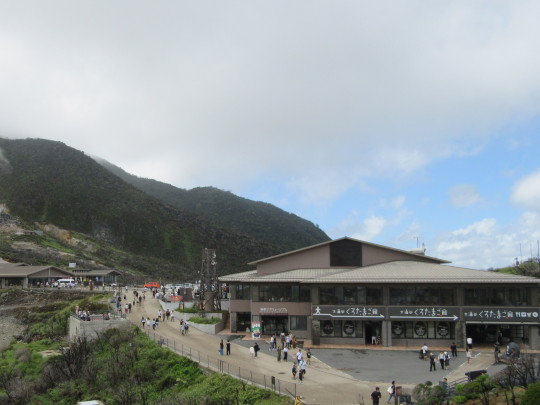
... or what to do on the summit of an active volcano. As inauspicious as that sounds, as long as Mount Hakone's activity can be described as moderate (localised fumaroles and hot springs) and a full-blown eruption doesn't happen, and that hasn't happened in thousands of years, it's possible to settle some permanent attractions. The Ropeway is undoubtedly one of them, and the Geomuseum, housing explanations about the mountain's history and geological peculiarities, was a very pertinent addition 10 years ago.

However, the summit's biggest draw has to be its black eggs. No, black eggs aren't what you get when you raise chickens at the top of an active volcano, but it's what you get when you boil eggs in the natural volcanic spring water on Mount Hakone.
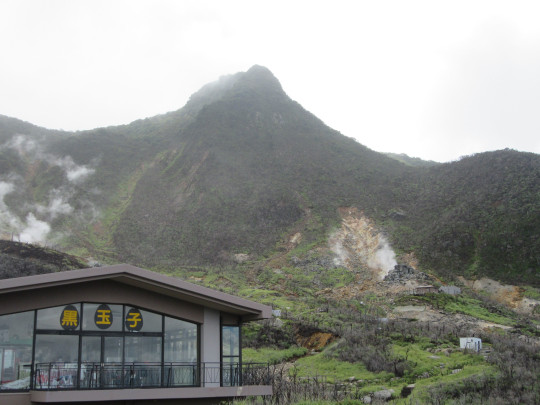
So a few restaurants have popped up in Ôwakudani to serve these curious delicacies. To be clear, it's just the shells that turn black due to the minerals in the hot spring water; they still protect the inside from those minerals, and the egg cooks perfectly normally, and the edible parts are still white and yellow. Apparently, I don't eat hard-boiled eggs.

The eggs are cooked in the steaming plant next to this fumarole further up the hill. It can be visited via a trail through some less stable ground. If I remember correctly, this trail is only open at certain times for a limited number of people at a time. Although it's only 300 metres from the main part of Ôwakudani, half a dozen shelters have been installed in case of emergency (one such concrete structure can be seen behind the steaming plant).
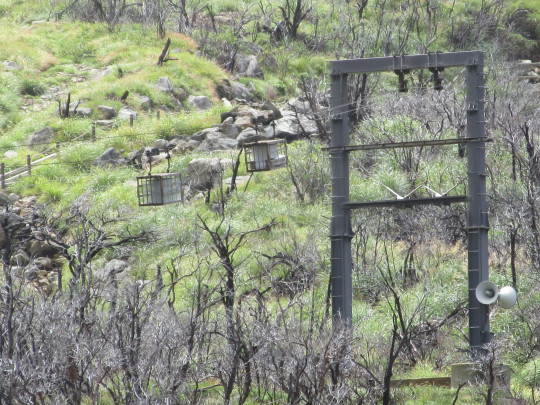
But how do the eggs get up there if the trail isn't always open? With their own lovely little ropeway! White eggs go up, black eggs come down, ready to be served in the restaurants!
#Japan#Kanagawa#Hakone#Ôwakudani#volcano#Geomuseum#black eggs#ropeway#I thought I had both black and white eggs in this picture#but the gondola going down is actually empty#if you look closely the one with eggs in them has padding under the cages#神奈川県#箱根#大涌谷#火山#箱根ジオパーク#黒たまご#ロープウェイ#2023-08
4 notes
·
View notes
Text
Top 7 Hill Stations in Japan to Visit
Japan, a country known for its bustling cities, historic temples, and delicious cuisine, is also home to breathtaking hill stations. These serene getaways offer visitors a chance to escape the urban rush and immerse themselves in nature. From hot springs and stunning landscapes to adventurous trekking trails, Japan’s hill stations provide a perfect retreat. Here are the top 7 hill stations in Japan to visit, where you can experience nature at its finest.

1. Hakone – A Blend of Nature and Hot Springs
Hakone is one of the most famous hill stations in Japan to visit, known for its relaxing onsens (hot springs), picturesque mountains, and views of Mount Fuji. Located just a short train ride from Tokyo, it is a popular weekend getaway for both locals and tourists.
Visitors can enjoy a boat cruise on Lake Ashi, explore the Hakone Open-Air Museum, and take a scenic ride on the Hakone Ropeway. The area is also home to Owakudani, a volcanic valley where you can witness steaming sulfur vents and taste the famous black eggs boiled in natural hot spring water.
2. Kamikochi – A Paradise for Hikers
If you love hiking, Kamikochi is a must-visit hill station in Japan. Nestled in the Japanese Alps, Kamikochi offers stunning views of snow-capped mountains, crystal-clear rivers, and lush greenery. The area is part of Chubu-Sangaku National Park and is known for its well-maintained trekking trails.
Popular hikes include the walk from Kappa Bridge to Myojin Pond and the more challenging trek to Mount Yake, an active volcano. Kamikochi is accessible from mid-April to mid-November, and during autumn, the landscape is transformed into a mesmerizing blend of red, orange, and yellow hues.
3. Nikko – A UNESCO Heritage Hill Station
Nikko is a historical and scenic hill station in Japan to visit, famous for its stunning temples and lush forests. The highlight of Nikko is the UNESCO-listed Toshogu Shrine, a beautifully decorated mausoleum of Tokugawa Ieyasu, the founder of the Tokugawa shogunate.
Nature lovers can explore Kegon Falls, one of Japan’s most spectacular waterfalls, and Lake Chuzenji, a serene mountain lake perfect for a peaceful boat ride. The autumn season in Nikko is particularly enchanting, with vibrant foliage painting the hillsides in breathtaking colors.
4. Karuizawa – A Luxury Retreat in the Mountains
Karuizawa is a sophisticated hill station in Japan to visit, known for its cool climate, luxurious resorts, and shopping districts. Located in Nagano Prefecture, Karuizawa has been a popular retreat for Tokyo’s elite since the Meiji era.
Visitors can explore Shiraito Falls, a delicate and picturesque waterfall, and the Karuizawa Prince Shopping Plaza, a high-end outlet mall. During winter, Karuizawa transforms into a ski destination, making it a perfect year-round getaway.
5. Beppu – The City of Hot Springs
Beppu is not just a hill station in Japan to visit, but also the country’s hot spring capital. Nestled between mountains and the sea, Beppu boasts over 2,000 hot spring sources, making it one of the best places to experience Japan’s onsen culture.
One of the main attractions is the “Hells of Beppu” (Jigoku), a series of colorful hot spring pools that are too hot for bathing but fascinating to observe. For relaxation, visitors can enjoy a variety of onsens, including sand baths and mud baths, offering a unique and therapeutic experience.
6. Mt. Takao – A Perfect Day Trip from Tokyo
Mt. Takao is a fantastic hill station in Japan to visit for those who want a quick escape from Tokyo. Just an hour away from the city, Mt. Takao offers a mix of natural beauty, hiking trails, and cultural sites.
The most popular route is Trail No. 1, which leads visitors through lush forests, past Yakuoin Temple, and up to the summit. On clear days, you can even catch a glimpse of Mount Fuji. The area is also famous for its autumn foliage and cherry blossoms in spring.
7. Shiretoko – A Remote Natural Wonder
Shiretoko, located on the northeastern coast of Hokkaido, is a remote hill station in Japan to visit for nature lovers and wildlife enthusiasts. It is a UNESCO World Heritage Site, known for its unspoiled natural beauty and rich biodiversity.
Visitors can explore the Shiretoko Five Lakes, go on a boat tour to see brown bears in the wild, or hike to the stunning Furepe Waterfall. In winter, the region is covered in snow, creating a magical landscape perfect for adventure seekers.

Conclusion
Japan is not just about skyscrapers and bustling cities; its hill stations offer some of the most breathtaking landscapes and relaxing experiences. Whether you’re looking for hot springs, hiking trails, historical sites, or just a peaceful retreat, these top 7 hill stations in Japan to visit have something for everyone. So pack your bags and get ready to explore Japan’s stunning mountain getaways!
0 notes
Text
🌸Discover the Enchanting Beauty of Ryokan, Japan ✨

Get it now from here
Japan is a land of timeless traditions, breathtaking landscapes, and unparalleled hospitality. Among its many treasures, Ryokan stands out as an iconic experience that captures the essence of Japanese culture. These traditional inns offer travelers a unique opportunity to immerse themselves in the serene beauty of Japan while indulging in luxurious comfort. Let’s explore why Ryokan should be your next travel destination! ✨
🏯 A Glimpse into Traditional Japanese Hospitality
Ryokans are more than just accommodations; they are cultural sanctuaries where you can experience authentic Japanese living. From tatami-matted rooms to futon beds, every detail reflects centuries-old traditions. Guests are welcomed with warm smiles, served exquisite kaiseki meals, and invited to relax in private onsen (hot spring baths).
The charm of Ryokan lies in its ability to transport you to a simpler, more peaceful time. Whether you’re sipping green tea overlooking a tranquil garden or soaking in natural hot springs, every moment feels like a step back into history.
🌄 Must-Visit Attractions Near Ryokan
While staying at a Ryokan, you’ll have access to some of Japan’s most stunning attractions. Here are a few highlights:
1️⃣ Hakone
Famous for its hot springs and views of Mount Fuji, Hakone is a paradise for nature lovers. Explore the Owakudani Valley, take a scenic cruise on Lake Ashi, and enjoy panoramic vistas from the Hakone Ropeway.
2️⃣ Kyoto
Just a short trip away, Kyoto offers a glimpse into Japan’s imperial past. Visit the iconic Fushimi Inari Shrine, stroll through the Arashiyama Bamboo Grove, and marvel at the golden pavilion of Kinkaku-ji Temple.
3️⃣ Nikko
This UNESCO World Heritage Site is home to ornate shrines, lush forests, and cascading waterfalls. Don’t miss the Toshogu Shrine, a masterpiece of Japanese architecture.
🛏️ Why Choose a Ryokan Stay?
Staying at a Ryokan isn’t just about lodging — it’s about creating memories. Imagine waking up to the sound of rustling leaves, enjoying a multi-course dinner prepared by skilled chefs, and unwinding in a private hot spring under the stars. It’s no wonder that Ryokans are considered one of Japan’s greatest treasures.
To make your dream vacation a reality, book your trip today through our trusted partner: Click here to reserve your flight and hotel ✈️🏨
🍃 Tips for an Unforgettable Ryokan Experience
Dress the Part: Wear a yukata (a casual kimono) provided by the Ryokan during your stay.
Respect Local Customs: Remove your shoes before entering rooms and follow bathing etiquette at onsens.
Plan: Ryokans are often small and exclusive, so reservations are essential.
📢 Ready to Embark on Your Journey?
Japan’s Ryokans blend tradition, luxury, and natural beauty perfectly. Whether you’re seeking relaxation, adventure, or cultural enrichment, this destination has something for everyone.
Don’t wait—start planning your trip now! Visit this link to book your flights and accommodations effortlessly and secure your spot .
Your journey to Japan begins here. Pack your bags, embrace the spirit of adventure, and let the enchantment of Ryokan captivate your soul! 🌟
#Best ryokan travel deals#how to book cheap deals#how to book cheap hotels#best ticket price#Best ticket deals#Japan Travel Goals#Ryokan Experience#Traditional Japan#Onsen Relaxation#Kaiseki Cuisine#Mount Fuji Views#Japanese Hospitality#Luxury In Japan#Explore Kyoto#Hakone Hot Springs
0 notes
Text
Japan day 7 (11/16)
More Hakone and then Tokyo!
Started by trying to watch the sunrise from the onsen. We mostly missed the actual sunrise but it was still really pretty

We then got breakfast in the room which was this cute little bento box.

We then went back up the ropeway and it was so clear and we got a great view of mt Fuji! One of the legs up we even got a car to ourselves which was cool and the views were great.


We then tried to get a picture with the water Tori gate, but the line was crazy long and so slow moving so we took a quick pic from the side and moved on. But I still got a cute pic by an adorable bridge! Sadly my eyes were closed so you get the slightly blurry Live Photo from when they were open 🤷♀️

When we finally made it Tokyo station I got dipping ramen and it was the best ramen I ever had and it was like 7 dollars which is crazy.


I also found this adorable penguin in a Christmas tree which I managed to not buy the first time but then went back later to get it 😂
We then wandered around took in the city views and the lake in park. We got drinks at this adorable owl themed brewery my bf likes and then got dinner and then magi carp custard for dessert



Overly long travel diary
Day 7
In the morning we try to catch the sunrise in the onsen. Official sunrise time is 6:18 and we get down there like 6:05 but it’s already pretty light and not very many fun colors. It’s still pretty tho. A little while later the sky gets some nice pink to it.
After we get all our onsen time in we head back up to the room. We still have like an hour before breakfast and finally get some quality time. I am annoyed by how much better this makes me feel, but here we are.
Breakfast is also a lot of fish and I’m over having food I don’t like.
Sunrise onsen.
Breakfast in cute little bento box.
Rooeway which is extra great because clear day and can see my Fuji.
After breakfast we head back to the rooeway. It’s like 9am so it’s pretty empty here and we get a car all to our selves on the way up which is really fun. It’s a clear day today so we can see my Fuji from the rooeway car which is fun too see. It really sticks out above the rest of the landscape. All of the other mountains are full of trees and green on top and then there’s Fuji looming in the background with its giant snow covered peak.
We also get a great view of the sulphuric vents.
When we get to the bottom we go to hike around the lake to a water Tori gate. Some of our way there is on a lovely path through the woods where you can see the lake. And some of it is along the road where you try not to get hit by cars
Try and take pic with the Tori water gate but the line is too long and moves too slowly. Everybody has waited for a while so they want their full photo shoot and it takes like five minutes per group. We don’t want to wait for a picture for like 45 minutes So instead we just take pictures and a selfie from the side and it’s fine.
As we walk back we do cross a really cute bridge and my bf offers (actually offers! ) to take a pic of me on the bridge. I had been wanting a cute bridge pic so I love it.
And then we take a bus and two trains to Tokyo.
We stop at Tokyo station to get ramen. We have to wait in a line for about 15 minutes. Then we quickly order at the vending machine and are seated. The music playing is very fast paced and it feels like everything is rushed. But it is very efficient. We get dipping ramen Where the noodles are in a separate bowl and are cold, and then you dip into the bowl filled with hot broth. It’s so delicious. Sometimes I don’t get the timing of the dip amount right and the noodles end up too hot or too cold but mostly it’s perfect. Anthony paid on his suica card. Mine was 1040 yen. Which is so crazy cheap for the best ramen I’ve ever had.
After we walk through the Tokyo station character street. It’s filled with adorable shops. I find the most precious penguin stuffed animal that’s wearing a Christmas tree and I nearly die of cuteness. (I don’t get it because I do not need a 30 dollar stuffed animal that will just sit in the pile in my room)
There’s also a bear themed store where I find a bear cutout that can be used to make bear shaped pancakes or omelette a. And at 1300 yen I have to have it.
Hotel
Walk around streets
Laundry
Izakaya for dinner
We head to the hotel to check in and then walk around the streets. I think walking around the streets of Tokyo is one of my favorite parts of the trip. They are all lined with so many little stores and there are just people everywhere bustling about. The streets are all really clean and everyone is really polite. Like the queues for things are always so well organized even when they aren’t marked it’s remarkable.
We do laundry at our hotel and then head out to izakaya, which is a Japanese things where you get drinks and grilled items, small plates style usually for sharing. They typically require at least one drink and food item per person. It’s so weird to me that there are places in Japan that will require you to order a drink. It doesn’t have to be alcoholic but as someone who rarely orders drinks and almost never non alcohol with meals it’s a bit odd to me. It’s usually places that are really busy.
The place we go to seems rather American food themed but all of the other people in there are Japanese and not tourists. Our waiter tho has excellent English. I get a mango beer and Anthony gets about her highball, his favorite Japanese thing. And we get garlic bread and a meat sample plate. There’s way too much food and we struggle to make it through most of it. Anthony keeps pushing for us to eat more because he’s convinced it looks bad or something to not eat most of it or is wasteful. I’ve clearly been spending too much time on the intuitive eating side of Instagram so I’m just like my body is not a trash can. Also if I’m too full for it to taste good why bother eating it? We eventually give up on it and head back to the hotel.
3 notes
·
View notes
Text
Hi everyone! 🤗
I’m planning a 20D/19N trip to Japan in June 2025 with my then almost-13-year-old son, and I’m looking for some suggestions for off-the-beaten-path places and experiences.
We’ll start with three nights in Tokyo and then head to Nikko for two nights. After that, we’re considering traveling down towards Kyoto and Osaka. We’re debating whether to rent a car for about a week to explore areas that are less crowded and more unique. Pick up and return in Tokyo OR Pick up and return in Osaka.
If you have any recommendations for hidden gems, small towns, scenic drives, or interesting activities we could include, I’d love to hear them! We’re especially interested in:
Nature and quieter spots
Historical or cultural experiences
Local food (mom) and fun stuff for a teenager.
Maybe someone here have done a trip similar to this and want to share their itinerary 🙏.
We’re also open to skipping the car rental if public transportation can easily get us to these kinds of places. Thanks in advance for your help! That sounds like a fantastic trip! Here are some suggestions for off-the-beaten-path experiences and scenic spots you might enjoy:
Around Tokyo & Nikko
Okutama (West Tokyo): A quiet escape with hiking trails, waterfalls (like Hatonosu Gorge), and hot springs.
Edo Wonderland (near Nikko): A theme park recreating the Edo period with samurai, ninja shows, and historical experiences your son might find fun.
Scenic Drives Near Tokyo
Nikko to Chuzenji Lake and Irohazaka Winding Road: A beautiful, historic drive with stunning views, especially if you include Kegon Falls.
Hakone or Fuji Five Lakes: Scenic routes around Mount Fuji, offering great spots for nature, local food, and some fun activities like boat rides or ropeways.
Kyoto to Osaka Region
Uji (between Kyoto and Nara): Known for its tea culture, Byodoin Temple, and serene riverside walks.
Miyama (north of Kyoto): A charming rural village with traditional thatched-roof houses.
Car Rental: Unique Routes
If you rent a car, here are a few itineraries:
1. Shirakawa-go and Gokayama (Alps Region): Gorgeous historic villages with a peaceful vibe. Stay in a traditional gassho-zukuri house.
2. Ise-Shima Peninsula: A blend of scenic coastal drives, the famous Ise Grand Shrine, and fresh seafood.
Public Transport-Friendly Gems
Kinosaki Onsen (near Kyoto): A beautiful onsen town where you can enjoy public baths, stroll in yukata, and sample local crab dishes.
Kurashiki (near Okayama): An artsy town with canals, charming streets, and hands-on workshops.
Teen-Friendly Ideas
Osaka: Universal Studios, the Pokémon Center, and try Takoyaki at a local stall.
Arashiyama (Kyoto): The bamboo grove, monkey park, and renting bikes along the riverside.
Let me know if you’d like help refining your itinerary! That sounds like a fantastic trip! Here are some suggestions for off-the-beaten-path experiences and scenic spots you might enjoy:
Around Tokyo & Nikko
Okutama (West Tokyo): A quiet escape with hiking trails, waterfalls (like Hatonosu Gorge), and hot springs.
Edo Wonderland (near Nikko): A theme park recreating the Edo period with samurai, ninja shows, and historical experiences your son might find fun.
Scenic Drives Near Tokyo
Nikko to Chuzenji Lake and Irohazaka Winding Road: A beautiful, historic drive with stunning views, especially if you include Kegon Falls.
Hakone or Fuji Five Lakes: Scenic routes around Mount Fuji, offering great spots for nature, local food, and some fun activities like boat rides or ropeways.
Kyoto to Osaka Region
Uji (between Kyoto and Nara): Known for its tea culture, Byodoin Temple, and serene riverside walks.
Miyama (north of Kyoto): A charming rural village with traditional thatched-roof houses.
Car Rental: Unique Routes
If you rent a car, here are a few itineraries:
1. Shirakawa-go and Gokayama (Alps Region): Gorgeous historic villages with a peaceful vibe. Stay in a traditional gassho-zukuri house.
2. Ise-Shima Peninsula: A blend of scenic coastal drives, the famous Ise Grand Shrine, and fresh seafood.
Public Transport-Friendly Gems
Kinosaki Onsen (near Kyoto): A beautiful onsen town where you can enjoy public baths, stroll in yukata, and sample local crab dishes.
Kurashiki (near Okayama): An artsy town with canals, charming streets, and hands-on workshops.
Teen-Friendly Ideas
Osaka: Universal Studios, the Pokémon Center, and try Takoyaki at a local stall.
Arashiyama (Kyoto): The bamboo grove, monkey park, and renting bikes along the riverside.
Let me know if you’d like help refining your itinerary!That sounds like a fantastic trip! Here are some suggestions for off-the-beaten-path experiences and scenic spots you might enjoy:
Around Tokyo & Nikko
Okutama (West Tokyo): A quiet escape with hiking trails, waterfalls (like Hatonosu Gorge), and hot springs.
Edo Wonderland (near Nikko): A theme park recreating the Edo period with samurai, ninja shows, and historical experiences your son might find fun.
Scenic Drives Near Tokyo
Nikko to Chuzenji Lake and Irohazaka Winding Road: A beautiful, historic drive with stunning views, especially if you include Kegon Falls.
Hakone or Fuji Five Lakes: Scenic routes around Mount Fuji, offering great spots for nature, local food, and some fun activities like boat rides or ropeways.
Kyoto to Osaka Region
Uji (between Kyoto and Nara): Known for its tea culture, Byodoin Temple, and serene riverside walks.
Miyama (north of Kyoto): A charming rural village with traditional thatched-roof houses.
Car Rental: Unique Routes
If you rent a car, here are a few itineraries:
1. Shirakawa-go and Gokayama (Alps Region): Gorgeous historic villages with a peaceful vibe. Stay in a traditional gassho-zukuri house.
2. Ise-Shima Peninsula: A blend of scenic coastal drives, the famous Ise Grand Shrine, and fresh seafood.
Public Transport-Friendly Gems
Kinosaki Onsen (near Kyoto): A beautiful onsen town where you can enjoy public baths, stroll in yukata, and sample local crab dishes.
Kurashiki (near Okayama): An artsy town with canals, charming streets, and hands-on workshops.
Teen-Friendly Ideas
Osaka: Universal Studios, the Pokémon Center, and try Takoyaki at a local stall.
Arashiyama (Kyoto): The bamboo grove, monkey park, and renting bikes along the riverside.
Let me know if you’d like help refining your itinerary!
0 notes